Allen Tiller's Blog, page 33
February 13, 2018
The Murder of Mary Legge
The Murder of Mary Legge
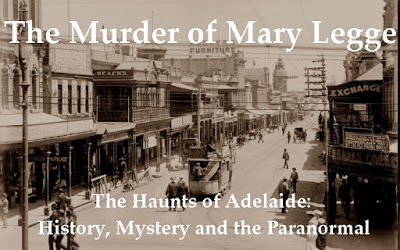
150 Hindley Street
“Lord save me” were the dying words of Mary Legge, laying on the floor of Gasons Lodging House, Hindley Street. Above her, as she breathed her last breath, stood her husband, enraged, with knife in hand. He threw his knife at her as he calmly walked out the door, the only witness, a man named Roskilley who had fought against Legge, but had backed away when threatened with the knife.
Legge hastily left the premises and headed down Hindley street. Roskilley also left, and found P.C. Irwin on the corner of Hindley and King William street, and told him of the murder. Legge, upon realising he had been identified, sprinted away from the Constable, the two men running full pace west along Hindley Street.
Another Constable, P.C. Allen, saw what was going on, and tackled Legge to the ground. Legge then stated to the two officers that he had stabbed his wife three times. The two Constables then escorted Legge back to the Police Station, and left him with the officer in charge, before heading back to Gason’s to evaluate the scene.
Mary Legge was lying in a pool of her blood, she had three stab wounds in her left shoulder blade, made by an ordinary bread and butter knife. One stab had punctured her left lung and another had pierced her heart, causing her to bleed out and die very quickly.
William Legge, was well known to Adelaide police as a habitual drunkard, but he hadn’t always been a heavy drinker. Only months prior he had run a successful painting business from Clarendon, and every mail from England (monthly) He received a hefty 16 pounds’ remittance from his wealthy parents.
Legge and his wife, Mary, a “pleasant looking young woman”, who had only been in South Australia for nine months, had been renting a room in Gason’s Lodging House. In the few months, they had been living in Adelaide, they had both become drunkards and were prone to physical altercations with each other. Mary was often heard swearing at William, and only a week previously had hit him in the head with a bottle, leaving a deep cut.
When the trial proceeded, the defence applied the “Temporary insanity” clause, and pointed out the constant beratement of William by Mary. It was pointed out that both were very drunk, and that William had quite calmly asked Mary to go to bed, and she had flatly refused then started abusing him. William had then stated, “If you don’t go to bed I will put an end to you”, Mary, again refused, and this was when William became so enraged (and according to the defence, temporarily insane) that he stabbed his wife to death.
William Legge’s charges were downgraded from murder, to manslaughter, due to the temporary insanity defence, and instead of facing being hung for the wilful murder of his wife, he was sentenced to just ten years’ imprisonment.
Researched and written by Allen Tiller.
© 2018 Allen Tiller
Like us on Facebook: https://www.facebook.com/TheHauntsOfAdelaide/
www.allentiller.com.auwww.eidolonparanormal.com.au
Bibliography
1870 'LAW COURTS.', The Express and Telegraph (Adelaide, SA : 1867 - 1922), 18 May, p. 2. (SECOND EDITION.), viewed 02 Jan 2018, http://nla.gov.au/nla.news-article207...
1870 'SHOCKING MURDER IN ADELAIDE.', Northern Argus (Clare, SA : 1869 - 1954), 25 March, p. 3. , viewed 02 Jan 2018, http://nla.gov.au/nla.news-article92777632
1920 'FIFTY YEARS AGO.', The Register (Adelaide, SA : 1901 - 1929), 22 March, p. 6. , viewed 02 Jan 2018, http://nla.gov.au/nla.news-article62618178

150 Hindley Street
“Lord save me” were the dying words of Mary Legge, laying on the floor of Gasons Lodging House, Hindley Street. Above her, as she breathed her last breath, stood her husband, enraged, with knife in hand. He threw his knife at her as he calmly walked out the door, the only witness, a man named Roskilley who had fought against Legge, but had backed away when threatened with the knife.
Legge hastily left the premises and headed down Hindley street. Roskilley also left, and found P.C. Irwin on the corner of Hindley and King William street, and told him of the murder. Legge, upon realising he had been identified, sprinted away from the Constable, the two men running full pace west along Hindley Street.
Another Constable, P.C. Allen, saw what was going on, and tackled Legge to the ground. Legge then stated to the two officers that he had stabbed his wife three times. The two Constables then escorted Legge back to the Police Station, and left him with the officer in charge, before heading back to Gason’s to evaluate the scene.
Mary Legge was lying in a pool of her blood, she had three stab wounds in her left shoulder blade, made by an ordinary bread and butter knife. One stab had punctured her left lung and another had pierced her heart, causing her to bleed out and die very quickly.
William Legge, was well known to Adelaide police as a habitual drunkard, but he hadn’t always been a heavy drinker. Only months prior he had run a successful painting business from Clarendon, and every mail from England (monthly) He received a hefty 16 pounds’ remittance from his wealthy parents.
Legge and his wife, Mary, a “pleasant looking young woman”, who had only been in South Australia for nine months, had been renting a room in Gason’s Lodging House. In the few months, they had been living in Adelaide, they had both become drunkards and were prone to physical altercations with each other. Mary was often heard swearing at William, and only a week previously had hit him in the head with a bottle, leaving a deep cut.
When the trial proceeded, the defence applied the “Temporary insanity” clause, and pointed out the constant beratement of William by Mary. It was pointed out that both were very drunk, and that William had quite calmly asked Mary to go to bed, and she had flatly refused then started abusing him. William had then stated, “If you don’t go to bed I will put an end to you”, Mary, again refused, and this was when William became so enraged (and according to the defence, temporarily insane) that he stabbed his wife to death.
William Legge’s charges were downgraded from murder, to manslaughter, due to the temporary insanity defence, and instead of facing being hung for the wilful murder of his wife, he was sentenced to just ten years’ imprisonment.
Researched and written by Allen Tiller.
© 2018 Allen Tiller
Like us on Facebook: https://www.facebook.com/TheHauntsOfAdelaide/
www.allentiller.com.auwww.eidolonparanormal.com.au
Bibliography
1870 'LAW COURTS.', The Express and Telegraph (Adelaide, SA : 1867 - 1922), 18 May, p. 2. (SECOND EDITION.), viewed 02 Jan 2018, http://nla.gov.au/nla.news-article207...
1870 'SHOCKING MURDER IN ADELAIDE.', Northern Argus (Clare, SA : 1869 - 1954), 25 March, p. 3. , viewed 02 Jan 2018, http://nla.gov.au/nla.news-article92777632
1920 'FIFTY YEARS AGO.', The Register (Adelaide, SA : 1901 - 1929), 22 March, p. 6. , viewed 02 Jan 2018, http://nla.gov.au/nla.news-article62618178
Published on February 13, 2018 01:00
February 6, 2018
The Phantoms of Morialta Falls
The Phantoms of Morialta Falls
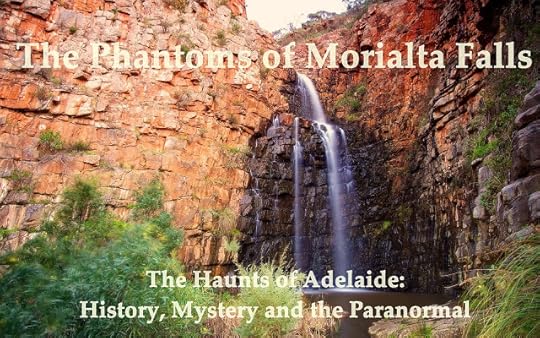
In the last few months of 2017, I was contact by multiple people about strange goings on in the carpark of the Morialta Conservation Park.
Morialta is just 10kms from the city of Adelaide, and has been a popular destination with locals for over 100 years. It contains three waterfalls along Fourth Creek, and has a network of extensive walking trails. It also contains a rock climbing zone.
Witnesses are reporting seeing phantoms in the park, human ghosts and those of phantom vehicles, with one being very strange indeed.Witness one recounted a story of being at the falls late one evening with two friends. They had gone for a drive “for something to do”, and found themselves at Morialta. They began to explore the walking trail, and could see quite clearly under the light of a full moon.
While walking along one of the trails heading towards a waterfall, they noticed ahead of them a peculiar white colour shape, that almost seemed to sparkle in the moonlight.
As they got closer they realised it was a young woman, (they determined this by the shape of the mist, and the fact it seemed to have long wavy hair past the shoulders).
The three of them stopped, all their hair standing on end, and watched as the female like white mist sparkled some more, then turned towards them, floating very quickly in their direction, before it vanished entirely.
They very quickly high tailed it out of there, back to their car, and have never returned to the park for more adventures!
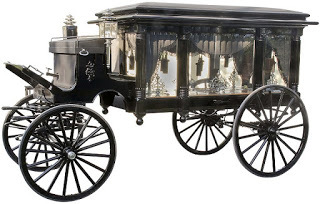
The second story recounted to me involves several people driving to the car park. As they entered they noticed a car parked by itself off to one side. There didn’t seem to be anyone in the car, so they figured the owners were off walking through the park and paid it no more attention.
The small convey had all parked near each other, and got out of their cars, laughing and joking when all of the sudden an eerie quiet fell over the group, and a feeling of foreboding overtook the mood of frivolity that had previously overcome the group.
As they stood there looking at each other, the temperature dropped very suddenly, and a mist formed around the group.
As they stood there, shivering, with mouths agape, wondering what the hell was going on, a large shaped moved through the mist and revealed itself right in front of their eyes. A very large, very black old horse drawn hearse, with no horses, silently glided into view between them, and headed towards the solitary parked car.
One of the girls screamed in terror, which seemed to break everyone’s stupor, and they all high-tailed it back to their cars and “booted” it out of there…
A further retelling of this story can be found online at: http://www.paranormal.com.au/public/index.php?topic=11298.0. This retelling of the same story also goes on to state that the next day one of the witnesses saw the car that had been parked in the carpark on the news. It was surrounded by police tape, as the night before the owner had committed suicide in the park (A detail omitted from the version told too me).
I can not confirm at this point that the story of the Hearse, in particular the suicide and subsequent news report are true, however, there have been plenty of deaths at the park.In 1917, 17-year-old Lyle Heddle died in the Adelaide Hospital from injuries suffered after falling from the cliffs at Morialta.
In 1926, the body of 27-year-old Alfred Jury was found lying in a pool of water at the base of the falls. His face had been badly disfigured, so much so in fact, that it could not be declared at the time if he had committed suicide with his rifle, or simply fell from the cliff tops and landed on his face.
His bike, with shot rabbits was later found at the top of the cliffs, but his gun never recovered. 1939, the body of 40-year-old Butcher, Robert Cantlon of Prospect, was found dead in the pool underneath waterfall one. Cantlon, it is thought, slipped at the top of fall one, trying to get a look over the edge.
In 1940, Royston Daniels, 13 of Prospect was killed when he fell 115ft from fall number one, trying to save his friend, Raymond Jenkins, who had slipped from rocks, half way down the cliff face.
Daniels died on impact.
In 1951, William Collins, 23 of Hyde Park, died at the falls after being struck in the head by a rock. The coroner of the day declared the death an accident, as at that time, throwing rocks, or rolling them down the hills at Morialta was a common practice, and it could not be determined from which direction the rock had come, nor if it had been thrown with ill intent.
Have you encountered any spirit activity at Morialta Falls?
Tell us about it over on the Facebook page!https://www.facebook.com/TheHauntsOfAdelaide/
Researched and written by Allen Tiller © 2018 – Allen Tiller – The Haunts of Adelaidewww.allentiller.com.auwww.eidolonparanormal.com.au
The following assets were used in the research and writing of this article:
1917 'FATALITIES AND ACCIDENTS.', The Advertiser (Adelaide, SA : 1889 - 1931), 2 August, p. 4. , viewed 18 Dec 2017, http://nla.gov.au/nla.news-article5540612
1926 'ACCUSED PERSON FOUND DEAD.', The Advertiser (Adelaide, SA : 1889 - 1931), 7 December, p. 15. , viewed 18 Dec 2017, http://nla.gov.au/nla.news-article40747312
1939 'WANDERED FOR HOURS', Recorder (Port Pirie, SA : 1919 - 1954), 12 July, p. 4. , viewed 18 Dec 2017, http://nla.gov.au/nla.news-article96360854
1940 'Fatal Fall At Morialta', News (Adelaide, SA : 1923 - 1954), 10 January, p. 5. , viewed 18 Dec 2017, http://nla.gov.au/nla.news-article131551924
1951 'Open Verdict On Falls Death', The Advertiser (Adelaide, SA : 1931 - 1954), 21 July, p. 3. , viewed 18 Dec 2017, http://nla.gov.au/nla.news-article45719767
National Parks South Australia, 2017, Morialta Conservation Park, Department of Environment, Water and Natural Resources, viewed 18 Dec 2017, https://www.environment.sa.gov.au/parks/find-a-park/Browse_by_region/Adelaide_Hills/morialta-conservation-park
Published on February 06, 2018 01:00
January 30, 2018
A Haunting at Minlaton, Yorke Peninsula
A Haunting at Minlaton, Yorke Peninsula
 It has been alleged that the Porter Building, located at 49-55 Main Street, Minlaton, Yorke Peninsula is haunted by a former lolly shop owner who died in a fire in 1958.Claims of a ghost causing paranormal activity in the building are common, with previous tenants claiming that objects would mysteriously move on their own, that doors and windows would, on occasion open and close with no human contact.
It has been alleged that the Porter Building, located at 49-55 Main Street, Minlaton, Yorke Peninsula is haunted by a former lolly shop owner who died in a fire in 1958.Claims of a ghost causing paranormal activity in the building are common, with previous tenants claiming that objects would mysteriously move on their own, that doors and windows would, on occasion open and close with no human contact.Cold spots have been reported, as well as cold breezes on scorching hot days, and at least one person claiming to witness a strange human-like apparition floating through the building, seen from outside.Previously to the current shops being constructed, the original buildings were a shop and small residence, which were owned by local council member Kevin (K.G.) King in the 1950’s.
Mr and Mrs King were dressmakers and set up shop in 1948, renting the premises from Mr Poole.
In the small residence lived 80-year-old Mabel Evelyn Lock, who once lived across Main Street with her husband, Edwin Ernest Lock, where they ran their own business, and where Edwin tended his prize winning garden.
Edwin passed away in 1940, and Mabel lived and worked in the town for a while longer, until moving into the residence alongside Mr Kings shop. On January 11th, 1954, W. J. McMahon, a neighbour, noticed smoke billowing from the Mrs Lock’s house. He called the fire brigade and the local doctor for help.
The fire was extinguished, but poor Mrs Lock was found dead in her bedroom.A coroner’s report stated that the cause of death was a heart attack, and the probably cause of the fire was that Mrs Lock had been carrying a candle as she made her way to bed. The candle fell forward onto the bed igniting the covers, and later Mrs Locks clothing. The coroner stated her death was firstly the heart attach, then asphyxiation from the smoke.
It has previously been stated online, that because of Mrs Lock’s death in 1954, that she is the ghost that haunts the building. This is of course speculation, unless someone can clearly identify the alleged spirit, then the ghost could obviously be anyone, but in stating that, her death, being shocking to her, could also be the foundation for her to haunt the building…
Have you visited the Porter Building at Minlaton on the Yorke Peninsula, and heard, felt or seen something paranormal? Let us know over on our facebook page at: https://www.facebook.com/TheHauntsOfAdelaide/Or in the comments section below.
© 2018 Allen TillerLike us on Facebook: https://www.facebook.com/TheHauntsOfAdelaide/www.allentiller.com.auwww.eidolonparanormal.com.au
Bibliography:
1948 'MINLATON', The Pioneer (Yorketown, SA : 1898 - 1954), 21 May, p. 6. , viewed 30 Dec 2017, http://nla.gov.au/nla.news-article199...
1954 'Found Dead in Smoke-Filled Bedroom', The Pioneer (Yorketown, SA : 1898 - 1954), 15 January, p. 1. , viewed 30 Dec 2017, http://nla.gov.au/nla.news-article204756613
1954 'Woman's body near blazing bed', News (Adelaide, SA : 1923 - 1954), 13 January, p. 1. , viewed 30 Dec 2017, http://nla.gov.au/nla.news-article134476027
Published on January 30, 2018 01:00
January 23, 2018
The Mysterious Death of Edward Shann
The Mysterious Death of Edward Shann
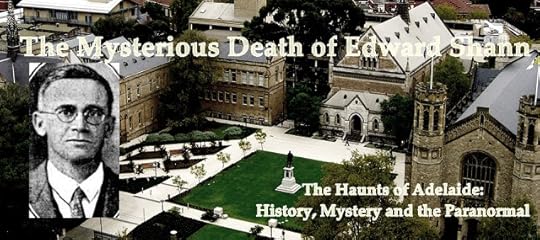 Edward Shann was born on the 30th of April 1884, in Hobart Tasmania, the youngest child of schoolmaster and journalist Frank Shann and his second wife Frances (nee Wood). Shann was educated firstly by his father, and after moving to Melbourne in the late 1880’s, via attendance at Wesley College, Queens College and University of Melbourne. He was a gifted young student, and despite set backs during the depression period of the 1890’s, of which he overcome by winning various scholarships, he achieved honours in History and Political Economy. Shann went on to become a much sought-after lecturer, finding work at the University of Melbourne lecturing on constitutional history, and later in Adelaide as an acting professor of philosophy at the University of Adelaide.
Edward Shann was born on the 30th of April 1884, in Hobart Tasmania, the youngest child of schoolmaster and journalist Frank Shann and his second wife Frances (nee Wood). Shann was educated firstly by his father, and after moving to Melbourne in the late 1880’s, via attendance at Wesley College, Queens College and University of Melbourne. He was a gifted young student, and despite set backs during the depression period of the 1890’s, of which he overcome by winning various scholarships, he achieved honours in History and Political Economy. Shann went on to become a much sought-after lecturer, finding work at the University of Melbourne lecturing on constitutional history, and later in Adelaide as an acting professor of philosophy at the University of Adelaide.In 1908, Shann left Australia for England, where he would study at the London School of Economics and broaden his knowledge by learning from various scholars of the day. He returned to Australia in 1910.
He became a lecturer at the University of Queensland (1911-1912), teaching history and economics.
In 1912, Shann moved to Western Australia and became a professor of history and economics at the University of Western Australia.
Shann’s career spanned the continent of Australia, and his influence on students at the time, was vast, directly influencing many great minds of the future, including Historian and Rhodes Scholar, John A. La Nauze.Shann, despite his heavy workload, still found time to write numerous books and essays about history and economics, including;
· An Economic History of Australia· Bond or Free?· Cattle Chosen: The Story of the First Group Settlement in Western Australia, 1829 to 1841· The Boom of 1890 – and Now
In 1930, Shann was invited by the Bank of New South Wales to become its economic consultant, a first of its kind position in Australia. Shann would go on to establish an economics department within the bank, another first for any bank in Australia.
In 1933, Shann accepted a chair of economics at the University of Adelaide, but he spent 1934, working in Perth, returning to Adelaide in 1935.
On the 23rd of May 1935, Shann gave his last lecture for the term, and collected his student’s papers and hurried off to his office. It is not known exactly what happened next, but 20 minutes later, at 7:40pm, Edward Shann was found by a student, Shann was lying in a pool of blood, on the ground, directly below his first-floor office window.
Shann’s watch had stopped at the time of impact, 7:35pm. His gold rimmed spectacles were laying nearby. An ambulance was called, and Shann was taken away, dying from the trauma of his fractured skull on the way to the hospital.
A coroner’s investigation led to a finding of suicide, based on the finding of a note in Shann’s home, that should any tragedy befall him in the near future, that his finances be taken care of by his will executor. Not a suicide note, but enough for the police at the time to conclude this was the case.
The police report of the incident noted that inside Shann’s office, which he shared with his assistant, John A La Nauze, there were no signs of a struggle. Shann’s coat and other belongings were exactly as they should be, the only things out of order were two pens found on the floor.
During interviews with staff and students that had interacted with Shann that day, and in previous weeks, it was established that Shann had been suffering form some form of exhaustion, that often led to dizzy spells, but for the most part, he was his normal cheerful self.
So, the question remains, did Edward Shann suffer from a dizzy spell, and accidentally fall out his office window, did he jump and end his own life or was it something more sinister? We will probably never know, but, if you would like to learn more about the circumstances and mystery surrounding Shann’s death, please read the essay “The Mystery of Edward Shann” by Alex Millnow (found here: http://www.freepatentsonline.com/article/History-Economics-Review/176776085.html).
Edward Shann was survived by his wife and three daughters. He was cremated in Adelaide, with memorial services provided in Adelaide and Perth.
The Edward Shann Memorial Lecturer, an annual event, was established in his honour in 1961. The University of Western Australia also erected the Shann Memorial in his honour.
Researched and written by Allen Tiller © 2017
www.AllenTiller.com.au
www.EidolonParanormal.com.au
The following assets were used to research and write this blog:
1935 'OBITUARY.', Northern Times (Carnarvon, WA : 1905 - 1952), 29 May, p. 3. , viewed 18 Dec 2017, http://nla.gov.au/nla.news-article74879584
1936 'EDWARD SHANN MEMORIAL FUND.', The Sydney Morning Herald (NSW : 1842 - 1954), 22 September, p. 10. , viewed 18 Dec 2017, http://nla.gov.au/nla.news-article172...
1936 'EDWARD SHANN MEMORIAL.', The West Australian (Perth, WA : 1879 - 1954), 28 October, p. 6. , viewed 18 Dec 2017, http://nla.gov.au/nla.news-article40972224
1937 'MEN I REMEMBER', Sunday Times (Perth, WA : 1902 - 1954), 6 June, p. 13. (First Section), viewed 18 Dec 2017, http://nla.gov.au/nla.news-article58781399
G. D. Snooks, 'Shann, Edward Owen Giblin (1884–1935)', Australian Dictionary of Biography, National Centre of Biography, Australian National University, http://adb.anu.edu.au/biography/shann..., published first in hardcopy 1988, accessed online 18 December 2017
Millnow, A, 2005, The Mystery of Edward Shann, History of Economics Review, History of Economic Thought Society of Australia, viewed 18 December 2017, http://www.freepatentsonline.com/arti...
Stuart Macintyre, 'La Nauze, Andrew John (1911–1990)', Australian Dictionary of Biography, National Centre of Biography, Australian National University, http://adb.anu.edu.au/biography/la-na..., published first in hardcopy 2012, accessed online 18 December 2017.
Published on January 23, 2018 01:00
January 16, 2018
A Haunting in Strathalbyn: The Ghost Larrikins
A Haunting in Strathalbyn: The Ghost Larrikins
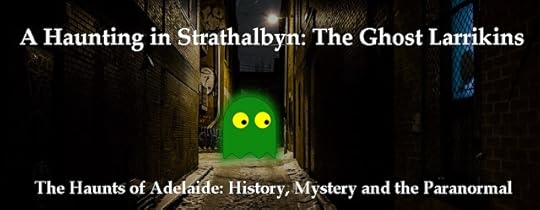 Before the Magistrates Court in Strathalbyn, 1887, an alleged ghost was put on trial for haunting an alleyway in the town.
Before the Magistrates Court in Strathalbyn, 1887, an alleged ghost was put on trial for haunting an alleyway in the town.The ghostly offender, who was brought to court after being captured by Corporal Cate, faced Magistrates E. Castle and W Colman, on the charge of Disturbing the Peace.The previous Wednesday night, a ghost was heard at midnight, wailing down the side alley of several houses. The nearby residents, woken by the strange sound, and a little fearful (these were superstitious times after all!) crept outside for a look.
One of the residents, Mr Joseph Wesley, armed himself with a dog chain, and made his way outside, then into the laneway. He saw a strange figure, draped in white that suddenly hid in the bushes. Wesley, decided to investigate further, and found the ghost, a young man wearing a puggaree (a thin muslin scarf tied round a sun helmet so as to hang down over the wearer's neck and shield it from the sun.)
The police were called, and after a little investigation, it was revealed that the ghost was none other than local, Ralph Wilson, a young man described as “half-crazy” in court proceedings, and therefore unable to plead for himself.
Wilson gave up two other young men, who had talked him into playing the ghost. Daniel Bray and J Stephens were both charged with aiding and abetting,
The three young men were very lucky to have received an excellent defense attorney in Mr E. J. tucker, who presented to the court a technicality, which allowed all three young men to walk free from court, but not without a warning from Judge Coleman, who warned them not to be seen in his court again!
...and so, another alleged ghost in Strathalbyn was unmasked!
Researched and written by Allen Tiller.© 2018 Allen TillerLike us on Facebook: https://www.facebook.com/TheHauntsOfAdelaide/www.allentiller.com.auwww.eidolonparanormal.com.au
Bibliography1877 'General News.', Southern Argus (Port Elliot, SA : 1866 - 1954), 24 May, p. 2. , viewed 30 Dec 2017, http://nla.gov.au/nla.news-article968...
1877 'MAGISTRATES' COURT, STRATHALBYN.', Southern Argus (Port Elliot, SA : 1866 - 1954), 31 May, p. 3. , viewed 30 Dec 2017, http://nla.gov.au/nla.news-article96886595
Published on January 16, 2018 01:00
January 9, 2018
A Haunting in Strathalbyn: Glowing Ghosts
A Haunting in Strathalbyn: Glowing Ghosts

In the winter of 1874 and 1875, ghost hunting fever overtook the residents of Strathalbyn, a small hamlet (at the time) 57 km’s southeast of Adelaide, not far from Lake Alexandria.
It all began when Mr W. T. Tregilgas, a local decided to take a short cut through the local cemetery on his early morning walk. Mr Tregilgas witnessed the outline of a woman on the top of an old tombstone. He claimed where the image appeared was dry to the touch, but where it did not appear was wet with early morning dew.
This sighting led to a national story about the case, and an influx of tourists trying to see the ghost for themselves.
It also led to numerous sightings in the town for many years afterwards.
In the same cemetery, at the same tombstone, a ghostly white figure, luminescent in the fading moon glow was seen laying on its side in the cemetery. The ghost was sighted by a small group of townsfolk, all of whom were far too frightened to enter the cemetery and investigate. The following day, members of the group told all and sundry about their ghostly encounter, while most just scoffed at the suggestion, others became curious.
The following night a group went to the cemetery, but the spectre did not appear. They kept their nightly vigil, always arriving just before midnight. Only a few nights later, the ghost had reappeared on the same tombstone, again, relaxing, laying on its side, glowing in the pale moonlight.
Non-believers became instant believers, but again, no-one was brave enough to venture into the cemetery and investigate the ghost. If they had, they would’ve discovered a well-known local joker, who had been investing heavily at Francis Millers local chemist shop in phosphorous and its anhydrous solvents!
For more information about this beautiful part of South Australia:
http://strathalbynsa.com.au/
Researched and written by Allen Tiller.© 2018 Allen TillerLike us on Facebook: https://www.facebook.com/TheHauntsOfAdelaide/www.allentiller.com.auwww.eidolonparanormal.com.auBibliography1912 'JOTTINGS.', Southern Argus (Port Elliot, SA : 1866 - 1954), 7 November, p. 3. , viewed 29 Dec 2017, http://nla.gov.au/nla.news-article96975184
Published on January 09, 2018 01:00
January 2, 2018
A Haunting in Strathalbyn: Ghost in the Cemetery
A Haunting in Strathalbyn: Ghost in the Cemetery

A Statement from Mr W.T. Tregilgas about the sighting of a spirit in the stone slab of a grave in a Strathalbyn cemetery was first published in 1871, in the Southern Argus (newspaper) as “The Ghost Story; Or What Gave Rise to It”. The alleged haunting caused a stir in the town, and became a national sensation as it was picked up and republished across Australia. This led to hundreds of people descending on the town trying to witness the ghost for themselves, and created a local urban legend that is still talked about even today!
The statement is as follows:
"Whilst taking a walk very early one morning, through some motive which I cannot account for, I was induced to walk through the burying ground, and coming to a grave surrounded by a wall, and covered with a slab of slate, I noticed on the slate something strange. It was scarcely light enough to see distinctly at first, but after waiting for some few minutes I could see it plainly, and it appeared to be a side view of a female.I could distinctly trace the head and body and the skirts, apparently full size. Not being satisfied with the sight I rubbed my hand on the form, and found that a portion of the slate was perfectly dry, whilst the parts outside the form were very wet with the dew which had fallen, and still not being satisfied I walked away, and came back in about fifteen or twenty minutes after, and still the form was there; so, I determined upon visiting it again next morning, which I did, and continued doing so for a week or more. During this time only saw the form once after the first morning; but not being a believer in supernatural appearances I tried to define the cause, but failed. In the course of conversation, I told Mr. Morton what I had seen, and he visited the place, and saw the form, although not so plain as it was when I saw it. The form was to be seen, and it has been seen since by others. Now, I believe there is some natural cause which produces this strange appearance, and perhaps some person upon reading this will be able to satisfy the minds of those who have seen it, for although many things have been advanced by people as to the probable cause, but none seem satisfactory to my mind, and those who have been eye-witnesses of the sight."These are the facts of the case, and they differ widely from the report circulated.By inserting the above explanation, you will greatly oblige me as well as others.
I am, sir, & c-,
W. T. TREGILGAS,
Strathalbyn.
July 3rd, 1871.
Researched and written by Allen Tiller.
© 2018 Allen Tiller
Like us on Facebook: https://www.facebook.com/TheHauntsOfAdelaide/www.allentiller.com.auwww.eidolonparanormal.com.au
Bibliography
1871 'THE GHOST STORY; OR WHAT GAVE RISE TO IT.', Southern Argus (Port Elliot, SA : 1866 - 1954), 14 July, p. 3. , viewed 30 Dec 2017, http://nla.gov.au/nla.news-article968...
1871 'ANOTHER GHOST STORY.', Empire (Sydney, NSW : 1850 - 1875), 24 July, p. 3. , viewed 30 Dec 2017, http://nla.gov.au/nla.news-article60874405
1871 'TRUE GHOST STORIES.', The Mercury (Hobart, Tas. : 1860 - 1954), 28 July, p. 4. , viewed 30 Dec 2017, http://nla.gov.au/nla.news-article887...
Published on January 02, 2018 01:00
November 28, 2017
"Accidental Death or “Spontaneous Human Combustion” - Gawler

I thought this week we might return to a blog wrote on The Haunts of Adelaide back on Tuesday, 15 April 2014 titled Accidental Death or “Spontaneous Human Combustion” (found here: http://hauntedadelaide.blogspot.com.au/2014/04/accidental-death-or-spontaneous-human.html)
This was a story I uncovered whilst researching various stories in my hometown of Gawler, that I thought interesting enough to be made public.
To sum up the story, it is about Mrs Margaret Nicholls, and elderly and feeble lady who took up residence in a small cottage in Gawler, owned by Mary Broderick. The cottage was situated on Finniss street in Gawler
On June 30th, 1883 Mrs Nicholls was found dead and there was much speculation as to how she died…some believed she was smoking in bed, and caused her bed clothes to ignite, thus burning her to death, others believed that a candle she often had lit as she went to bed, caused a fire on a nearby chair, that then took hold of her bedding, burning the poor woman to death.The official outcome by a jury after the inquest held in Mrs Nicholls Death:
"That the deceased was accidentally burnt to death, but there was no evidence to show how the fire originated." [1]
It would seem my questioning of the details of the case have come into question, particularly for propping that it could POSSIBLY be a case of spontaneous human combustion, but with the above conclusion by the jury, and evidence supplied by local Police Constable Doherty, once can speculate that the possibility of spontaneous human combustion is entirely possible! (please note, I have NEVER said it has been proven either way as to what caused the fire).
Evidence given by Police Constable M. Doherty, Gawler Police, during the inquest. (printed in the South Australian Advertiser Mon 2ndJuly 1883.)
He was called at 7.30 a.m. on Saturday to deceased's house. He saw some feathers on the floor and in the back yard. Thos. Hutchins pointed out the remains of the deceased. A portion of the right foot was lying nearly under the front bar of the bedstead. The left foot was about a yard distant from the other. The whole of the trunk was consumed, as were also the legs and arms—in fact everything but the head.The head was burning when he arrived, and he put water upon it. There were some portions of flannel wrappers round the neck, and the head had been covered by calico pinned tightly round. There were no stockings on the feet, and there was about five or six inches of the shin attached to the left foot. A portion of the mattress had been burned.There was no trace of any bedclothes on the floor besides those which were around the head.
What we DO know about Mrs Nicholls death. She was not smoking in bed at the time. The fire was not caused by a pipe that threw ashes into the bed, as speculated in one newspaper, there was no conclusive proof of a candle, or any other fire source being present in the room.
The evidence of an accidental death by fire was so inclusive that a jury of police, doctors and other learned people could not find a conclusion for the fire, nor how Mrs Nicholls body could be so fire ravaged that only sections of her remained, yet other furniture and rugs in the room had no damage from flames…with regard to the statements above, taken from the inquest report, one can speculate, as I did, that spontaneous human combustion is entirely possible in this situation!
We can all come to our own conclusions about what happened to Mrs Nicholls, but we cannot deny the jury’s outcome, or the inquest outcome. We can also not deny the amazing similarities between the circumstances of Mrs Nicholls death, and the state of her body, against those of other spontaneous human combustion cases around the world.
Was it spontaneous human combustion? We will never know…rest in peace Mrs Nicholls…
Researched & Written by Allen Tiller - 2017 Emerging South Australian Historian of the Year.
https://www.facebook.com/AllenHauntin...
More About Spontaneous Human Combustion. Arnold, Larry E. Ablaze! The Mysterious Fires of Spontaneous Human Combustion. New York: M. Evans & Co., 1996.
Howard K, 2017. Spontaneous Human Combustion: Fact Or Fiction?. All That is Interesting, viewed 17 November 2017, http://all-that-is-interesting.com/spontaneous-human-combustion .
1883 'DEATH BY BURNING.', The South Australian Advertiser (Adelaide, SA : 1858 - 1889), 2 July, p. 6. , viewed 17 Nov 2017, http://nla.gov.au/nla.news-article337...
1883 'DEATH BY BURNING.', The South Australian Advertiser (Adelaide, SA : 1858 - 1889), 2 July, p. 6. , viewed 17 Nov 2017, http://nla.gov.au/nla.news-article337...
Published on November 28, 2017 01:00
November 21, 2017
A Haunted Doll: Emiri
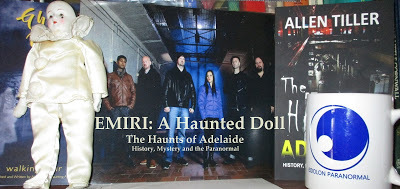
Emiri came from the United States in 2010. I bought her from ebay, with little hope she was actually haunted, but with the thought of, if she might be, it would be interesting to experiment with her, and see if I could gather any data via experimentation.
The following letter came attached with Emiri:“This doll belonged to my Mother, she used to take her everywhere. Emiri loves car rides, she has always been talkative, she also likes to draw with coloured pencils, especially red ones.
She rode a lot when she was alive and still loves it, along with travel games.She says she choked on some fast food and died, it seems like it was French fries. She is easily annoyed, and doesn’t like to be handled and cuddled a lot.
She likes to quietly play.
We have seen her move and our belt buckles in the car buckle on their own. When inside her host changes positions, or ends up flipped over.She prefers to be away from other dolls.”
I ran countless experiments with different gadgets, but to no avail, nothing ever came from anything I tried. I did, on occasion ask psychics, who knew nothing about the dolls past, to hold her, and only one, a sensitive person, who claimed no special abilities, was able to deliver something very similar to the back story provided by the original owners.
At the time that intrigued me, but In retrospect, it was much more likely to be coincidence, or they had seen the same doll for sale online!
Emiri travelled to a lot of locations that I investigated, including St Johns Cemetery near Kapunda, but her real claim to fame was on TV show Haunting: Australia, where she had a minor role in the Gledswood Homestead episode.
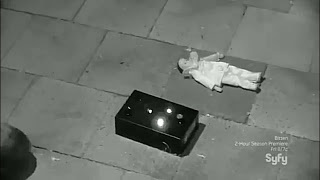 I used Emiri on the show to see if myself and Ian Lawman could interact with the spirit of a small girl, that psychic Rayleen Kable had felt died in a small room just a little bit away from the main homestead, thought to be quarters set aside for convict workers. Whilst we were in the room, Ian and I noted temperature drops, and high EMF readings (the readings were cut from the episode), but no other equipment registered anything abnormal. Later it would be revealed that when Rayleen was investigating the room, she picked up on a young girl named Isabel.
I used Emiri on the show to see if myself and Ian Lawman could interact with the spirit of a small girl, that psychic Rayleen Kable had felt died in a small room just a little bit away from the main homestead, thought to be quarters set aside for convict workers. Whilst we were in the room, Ian and I noted temperature drops, and high EMF readings (the readings were cut from the episode), but no other equipment registered anything abnormal. Later it would be revealed that when Rayleen was investigating the room, she picked up on a young girl named Isabel.Isabel would reveal herself through an EVP, in which she clearly replies with the answer of “yes” to one of Rayleen’s questions.
I don’t believe Emiri to be haunted, but I am also not a psychic, and maybe she won’t reveal herself to me, but as many of you know, there are no strict answers in the spiritual realm, so could Emiri and Isabel have met on the spiritual plane, and interacted, thus giving the sensations of cold spots, breathing sounds and EMF readings, or was it just our imaginations being hyped out about investigating an allegedly haunted location, and with the tiredness that creeps in after running such a tight shooting/ investigation schedule (Gledswood was the third location we filmed after Woodford Academy and Australiana Pioneer Village).Head on over to my facebook page at: https://www.facebook.com/AllenHauntin... to watch a short video from the episode.
So what do you believe? Can a doll be a container for a spirit to dwell? Can an object be haunted?
Tell us your thoughts over on the Haunts of Adelaide Facebook page: https://www.facebook.com/TheHauntsOfAdelaide/
Thanks for reading!Allen
Published on November 21, 2017 01:00
November 14, 2017
Lance Tiller: Credit Union Christmas Pageant
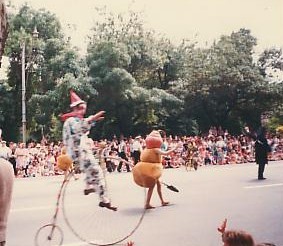 Lance Tiller: Credit Union Christmas PageantAcross 5 decades, and for 40 consecutive years, my uncle, Lance Tiller, rode his penny farthing bicycle in the historic John Martins Christmas Pageant, now known as the Credit Union Christmas Pageant.
Lance Tiller: Credit Union Christmas PageantAcross 5 decades, and for 40 consecutive years, my uncle, Lance Tiller, rode his penny farthing bicycle in the historic John Martins Christmas Pageant, now known as the Credit Union Christmas Pageant.The Penny Farthing was invented in 1870 in England (also known as the High-wheel). The name Penny Farthing comes from two English coins, used to describe the bikes wheels, due to their size.My uncles Penny Farthing once belonged to a gentleman at Middle Beach, named Samuel Temby. (as an interesting side-note, my Uncle owned the Middle Beach caravan park for several years during the late 1980’s early 1990’s, and I believe my grandfather’s pool table is still there!)
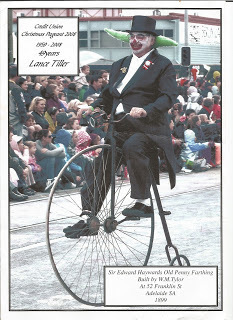
Mr Temby’s son began to ride the bike around Middle Beach. Later he moved to Mallala, and the old bike was put in the shed, and mostly forgotten.
In the late 1950’s my uncle purchased the penny farthing from the Tenby’s and learned how to ride the bike. Its seat sat 1.5 metres in the air, and one had to run alongside the bike, and use a small step to jump up into the seat!
It was in Gawler that Lance applied for a position in the John Martin’s Christmas Pageant. In a story shared with me by my uncle, he claims that the members of the pageant drive out to Gawler, and asked him to ride the penny farthing in traffic up and down the main street of Gawler, to prove he had control of the bicycle.
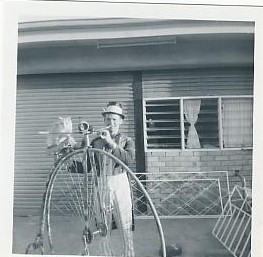 At my parents in Gawler, circa 1965
At my parents in Gawler, circa 1965It must’ve worked, as he rode in the pageant for many years afterwards, sometimes dressed as a clown, other times riding alongside the English bus.
Lance only retied after a pageant in the early 2000’s in which a member of the large crowd, dressed in wolf costume, leaped from the audience and slammed into his bike, causing Lance to fall heavily from the height of the seat – an injury as a sixty something year old man at the time, he has never fully recovered from.
The Credit Union Christmas Pageant has been one of the highlights of my Uncles life, and his face and eyes light up whenever he speaks of it, so I thought, I would share some of his story with you, before father time catches up with him, and his story is forgotten.
Perhaps, one day, I might take up a position with the Adelaide Credit Union Christmas Pageant, and continue my uncles tradition!
The Mallala Museum bought Uncle Lance’s Penny Farthing bicycle and it is still on display as an exhibit.
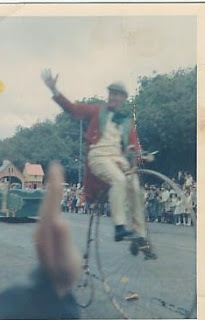
Mallala Museum, 2013, Penny Farthing Bicycle, Now and Then Mallala, viewed 5 Nov 2017, http://mallala.nowandthen.net.au/Penn...
Written by Allen Tiller © 2017
Published on November 14, 2017 01:00



